Institute for Electronics and Nanotechnology Builds the Future Microelectronics Workforce
May 02, 2024 —

When Amy Bonecutter-Leonard was a second-semester undergraduate at the Georgia Institute of Technology, she applied for a work-study job in the cleanroom at the Microelectronics Research Center (MiRC). There, she learned process techniques for making the same type of electronic chips used in cellphones.
With this new knowledge, she could train and help other students with their research. At the time, Bonecutter-Leonard was a chemical engineering major with no plans to go into microelectronics. Working in the cleanroom changed that.
“I fell in love with microelectronics through exposure to the research and development work performed in the cleanroom,” she said.
What started as a student job led to her taking microelectronics classes — and eventually to a career in the field. “My work-study prepared me with hands-on technical skills I would have never learned from just being in a classroom,” she said. Now, Bonecutter-Leonard works as a microelectronics business chief engineer at defense contractor L3Harris Technologies.
Her story is one of many from the Institute for Electronics and Nanotechnology (IEN, the successor to MiRC), which has been training students from kindergarten to graduate school to be leaders in the microelectronics and nanotechnology space. The goal of IEN’s outreach is to make nanotechnology and microelectronics — such as computer chips and sensors — as accessible as any other science. Ultimately, these efforts will build up the U.S. workforce in the field, ensuring the country remains at the forefront of the technology that powers Americans’ everyday lives.
Building the Workforce
Bolstering the number of workers in the microelectronics industry is imperative to keep the U.S. globally competitive. Right now, 40% of the industry's labor force is older than 50, with practitioners aging out of their careers at a pace new talent cannot match. Additionally, heavy educational barriers to entry, including required degrees and specialized training, prevent more people from pursuing careers in the field. Without dedicated efforts, the entire sector — and the nation — will fall behind.
IEN is working to solve this pipeline problem.
“With the national semiconductor workforce aging, it is important now more than ever that we educate the next generation to move into these jobs,” said Michael Filler, IEN’s interim executive director. “IEN is proud to support the semiconductor industry by providing students with the interdisciplinary skills and hands-on technical training essential for success in this fast-paced, global field.”
Georgia Tech is uniquely positioned to lead this charge with its 28,500 square feet of academic cleanroom space, the largest in the Southeast and among the largest in the U.S. From micro-electro-mechanical systems to electronics fabrication, workers have 100 bays in which to conduct leading-edge research. These cleanrooms are also key teaching and training facilities.
IEN invites anyone from around the world, whether affiliated with the Institute or not, to become a core user of the cleanroom facilities. The center also regularly hosts short courses for external partners — academic, industry, and government — in microfabrication and soft lithography for microfluidics. Over the past three years, more than 700 people went through new-user orientation, and 193 enrolled in the short courses.
Teaching the Next Generation
Making nanotechnology — of which microelectronics is an example — educationally accessible begins before college. Each semester, more than 800 K-12 students participate in IEN’s Introduction to Nanotechnology virtual lesson. Associate Director for Education and Outreach Mikkel Thomas begins his presentations by asking a simple question: What do you know about nanotechnology?
“About 99% of the time, they say that’s what makes Ironman’s suit work,” said Thomas. “That means they’ve learned the wrong lesson — that nanotechnology is a futuristic tech and that you have to be as smart as Tony Stark to work in the field.
“But most people interact with nanotechnology multiple times throughout their day, and they have no idea they're doing it.”
Thomas also emphasizes there is a career path for everyone, even if they don’t plan to get a traditional four-year degree. Part of IEN’s workforce development initiative is to build up the entire pipeline from industry and research lab technicians at the certificate level to postdoctoral researchers.
“It’s important for us to reach kids who don’t know what career options are available in nanotechnology,” Thomas said. “We want them to know that whatever they're interested in, there is a pathway for them.”
Sixth- through eighth-grade students sparked by this conversation can attend Chip Camp, a three-day STEM summer camp sponsored by Micron. They begin with a day at IEN to learn about thin films, magic sands, ferrofluids, and measuring their height in nanometers. The rest of the camp features hands-on visits to the Materials Characterization Facility (MCF) and the IEN cleanroom, where they can try on the white “bunny suits” technicians wear in the lab.
To further their reach, IEN’s workforce development team collaborates with teachers to bring nanotechnology into classrooms. During the summer, IEN offers the Research Experience for Teachers, a training program for public school and community college teachers to conduct nanotechnology research and learn how to incorporate it into their lessons. Middle school teachers have similar opportunities through the Nanoscience Summer Institute for Middle School Teachers.
Training the Workforce
When these students get to a university like Georgia Tech, IEN hires them for work-study jobs like the one Bonecutter-Leonard had. The hands-on cleanroom training is also vital to graduate students pursuing advanced degrees.
Katie Young earned her Ph.D. in materials science and engineering at Georgia Tech. Learning her way around the IEN cleanroom was essential for her graduate studies.
“My dissertation research involved synthesizing two-dimensional materials — only a single atom thick — for permeation barriers,” she explained. “I often used the cleanroom’s vacuum systems to synthesize and process 2D materials.” Now a research scientist at the Georgia Tech Research Institute, Young still works in the cleanroom on semiconductor device fabrication, building prototype quantum and biological sensors.
IEN opportunities are not limited to graduate research. Annually, about 150 Georgia Tech undergraduate students take microelectronics packaging and devices classes, with labs taught by IEN staff in the teaching cleanroom. These courses include Integrated Circuit Fabrication (ECE 4452), in which students learn to fabricate circuit elements, and the Science and Engineering of Microelectronic Fabrication (ChBE 4050/6050, open to graduate students as well), for students interested in semiconductor materials and fabrication.
Students don’t need to enroll at Georgia Tech to benefit from training, courses, and other opportunities. IEN’s internship program provides technical college students with training to become microelectronics technicians, either through work in the Biocleanroom or in the MCF.
Empowering Future Innovators
IEN also participates in the National Science Foundation Research Experiences for Undergraduates (REU), which provides opportunities for students from underrepresented groups or who attend schools without similar facilities. While enrolled at another university, John Mark Page was introduced to Georgia Tech’s cleanroom through an REU.
“That was my first exposure to any facility of this kind, and it felt like I was looking at the future. Being in a facility that can fabricate devices at or near the atomic level — it was hard to fathom,” Page said. “I had never thought that participating in microelectronics and nanotechnology as a student, especially as an undergraduate, was something I could do.”
As a result of his REU, Page transferred to Georgia Tech — he will graduate this summer with a bachelor’s degree in electrical engineering. He also completed a second REU at the University of North Carolina at Chapel Hill, worked as a student assistant in the IEN cleanroom, and participated in a Vertically Integrated Project (VIP), Chip Scale Power and Energy.
“I was interested in the VIP because it allowed me to spend more time in the cleanroom, familiarizing myself with semiconductor fabrication methods and training on new fabrication equipment,” Page explained. His experiences inspired him to consider a future career in the semiconductor industry.
“It wasn’t only the 10-week experience of the REU that made a lasting impact on me,” he said. “It was also the relationships formed with the people of IEN. The staff there are exceptional representatives of Georgia Tech, and they make IEN a tremendous asset to the future of microelectronics and nanotechnology in the U.S.”
Biya Haile, an ECE Ph.D. student, had a similarly meaningful REU experience. Haile, whose research focuses on creating micro-electro-mechanical systems-based sensors (MEMS), described the REU as “immersive.”
“The REU project enabled me to study chemical micro-sensor technologies, as well as state-of-the-art additive nano-manufacturing techniques, which has contributed to my research,” he said. “I feel lucky that my academic journey has entailed developing new technologies that use nanoscience to solve big problems.”
While Haile is currently focused more on designing and testing rapid processes for fabricating MEMS-based devices, he still occasionally works in the cleanroom on fabrication. He plans to go into the microelectronics industry after graduating.
The Path Ahead
All of IEN’s training and educational offerings align with IEN’s mission to bolster and diversify the microelectronics workforce, according to George White, senior director of strategic partnerships for the Georgia Tech research enterprise. “IEN has been at the forefront of the CHIPS infrastructure buildout, particularly in the area of education and workforce development,” he noted.
IEN’s efforts impact not just Atlanta but the entire country. Georgia Tech’s leadership in microelectronics research trains the innovators and practitioners of the future everywhere and ensures that America stays at the forefront of leading-edge technology. As demand increases for microelectronics, IEN is moving to meet it.
Effective July 1, 2024, the Institute for Electronics and Nanotechnology and the Institute for Materials will evolve into the Institute for Matter and Systems (IMS). This strategic union aims to foster convergent research at Georgia Tech, focusing on the science, technology, and societal underpinnings of cutting-edge materials and devices. Eric Vogel will be the director of IMS, and Michael Filler will be the deputy director.

Media Contact: Tess Malone, Senior Research Writer/Editor tess.malone@gatech.edu
Machine-Vision In-Situ TEM, Worfkow Solutions, Data Management and AI Platform Seminar
AGENDA
10:00 AM - 10:10 AM
Welcome and Introduction
Gabriela Mendoza, US Central Sales Manager
10:10 AM - 10:50 AM
Presentation: In-Situ TEM Workflow Solutions
Gabriela Mendoza, US Central Sales Manager
11:00 AM– 11:40 AM
AXON Studio Workshop
Tim Eldred, Product Marketing Manager
SPEAKER
Tim Eldred, Ph.D.
XPS Workshop
Register now to attend this FREE XPS Workshop on May 8th & 9th, 2024 to learn how X-ray Photoelectron Spectroscopy (XPS) can be used to investigate cutting-edge materials via surface chemistry and the elemental as well as electronic state of atoms.
Why you should attend:
- Expand your understanding of XPS for materials analysis.
- Speak directly with experts about today’s instrumentation & how it can work for you.
- Experience hands-on demonstrations and presentations.
Vogel to Lead Institute for Matter and Systems
Apr 22, 2024 —
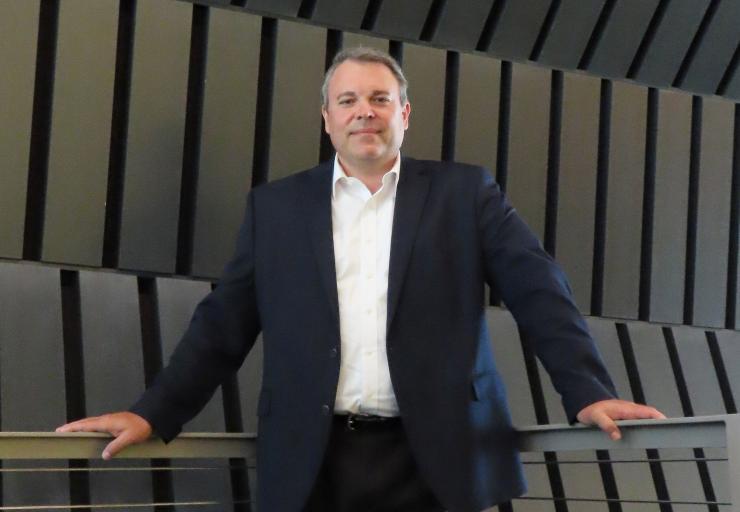
Effective July 1, Eric Vogel will become the executive director of the Institute for Matter and Systems (IMS), Georgia Tech’s newest Interdisciplinary Research Institute (IRI) that will launch on the same date.
As an evolution of the Institute for Materials (IMat) and the Institute for Electronics and Nanotechnology (IEN), IMS aims to enable convergent research at Georgia Tech related to the science, technology, and societal underpinnings of innovative materials and devices. Additionally, IMS seeks to integrate these innovations into systems that enhance human well-being and performance across information and communication, the built environment, and human-centric technologies that improve human health, wellness, and performance.
“Executive Vice President for Research Chaouki Abdallah and I are very excited about the launch of IMS, which positions Georgia Tech for integration of science and technology from atoms to devices, while explicitly drawing in researchers in the social sciences, design, business, and computing,” said Vice President of Interdisciplinary Research Julia Kubanek.
“IMS will ensure relevance across Georgia Tech through its newly configured Internal Advisor and Ambassador Board with representation across all six Colleges and GTRI,” she said. “Additional advisory committees representing IMS employees and facility users will ensure that we don’t sacrifice any of the research excellence for which IEN and IMat are known. With IMS I expect we will be even better positioned to tackle research problems that will have the greatest positive societal impact.”
Vogel will continue in his current position as the executive director of IMat until the launch of IMS. In addition to leading and growing IMat, Vogel is the Hightower Professor of Materials Science and Engineering at Georgia Tech’s School of Materials Science and Engineering, and he served as the IEN deputy director prior to leading IMat.
“It is an honor to be appointed executive director of the Institute for Matter and Systems, and I look forward to collaborating with the talented faculty and staff associated with it,” said Vogel. “This opportunity allows us to leverage the core competencies of IEN and IMat while extending our capabilities beyond nanotechnology and materials science. Together, we will be a hub for interdisciplinary research ranging from advanced materials to complex systems that solve global challenges.”
Georgia Tech’s IRIs facilitate collaboration between researchers and students from its six Colleges, the Georgia Tech Research Institute, national laboratories, and corporate entities to tackle critical topics of strategic significance for the Institute as well as for local, state, national, and international communities. IMS will also house and maintain the state-of-the-art Materials Characterization Facility and one of the largest academic cleanrooms in the nation, which offers a broad range of fabrication capabilities from basic discovery to prototype realization.
Before joining Georgia Tech in 2011, Vogel was an associate professor of materials science and engineering and electrical engineering at the University of Texas at Dallas. During this time, he also served as the associate director of the Texas Analog Center of Excellence and led UT Dallas’s involvement in the Southwest Academy for Nanoelectronics.
Prior to UT Dallas, he led the CMOS and Novel Devices Group and established the Nanofabrication Facility at the National Institute of Standards and Technology. Vogel holds a Ph.D. in electrical engineering from North Carolina State University and a B.S. in electrical engineering from the Pennsylvania State University. His research focuses on the development and fundamental understanding of electronic and nanomaterials and devices.
Laurie Haigh
Research Communications
NNCI Societal and Ethical Implications Webinar: Philanthropic Funding of Scientific Research
While a lot of funding of academic labs comes from Federal government agencies, philanthropies are playing an increasingly important role in supporting the scientific enterprise. The mission, goals, and administration of philanthropies are, however, quite different from organizations like the NSF and DOE. This webinar will bring together a panel of experts with extensive experience at philanthropies. We will host a 30-40 minute discussion about the landscape of philanthropic funding for scientific research, followed by ample time for questions from the audience.
ARM Lunch, Learn, Engage | Generalizable Robotics in Lab Automation
Professor Animesh Garg (COC) will lead a discussion around how the advent of language- and image-based foundation models promises to solve long standing challenges in robotics such as general-purpose perception and reasoning. This new capability has accelerated the autonomy of robotics, and as a result these systems are increasingly viable for flexible automation in scientific labs. We will present a framework for robot planning with visual feedback in the loop to solve open world reasoning.
Special MEMS Industry Invited Lecture | High-Performance Fused-Silica Vibratory Micro Shell Resonator Gyroscope
Abstract: Enertia Micro is commercializing a novel high-precision MEMS gyroscope technology called the birdbath resonator gyroscope (BRG) for rapidly emerging applications requiring excellent performance, small size, low power, and low cost (e.g. autonomous vehicles, industrial robots, consumer electronics, and aerospace applications). The BRG is the world’s first fused-silica vibratory MEMS gyroscope and is a near-navigation-grade MEMS gyroscope (i.e. in-run bias stability < 0.01 deg/hr).&
Empowering Research Faculty: Georgia Tech’s Strategic Plan
Apr 02, 2024 —
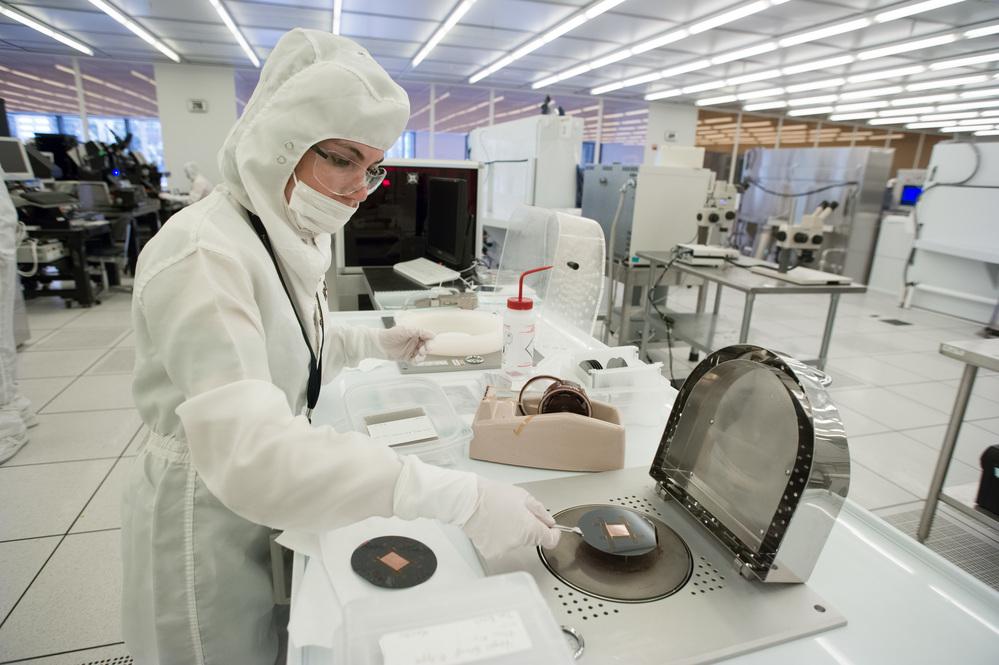
A research scientist from the Institute for Electronics and Nanotechnology (IEN) works in a clean room at the Marcus Nanotechnology Building. Research faculty are the non-tenure track faculty who carry out crucial research in labs, centers, and departments across campus. (Credit: Rob Felt)
Georgia Tech is supporting career growth for its research faculty, who do critical work at the heart of the research enterprise.
The word faculty is often synonymous with tenure-track professors — the individuals who teach courses and run major labs with their surnames in the title. But while groundbreaking discoveries regularly happen at Georgia Tech, the people doing the day-in, day-out research aren’t always visible.
Research faculty are non-tenure track faculty who carry out crucial research in labs, centers, and departments across campus. They are the lifeblood of research enterprises at major universities like Georgia Tech, but their work often occurs behind the scenes.
To support these essential employees, Georgia Tech launched an initiative to recognize and develop research faculty, who comprise 60% of the nearly 4,400 total faculty currently employed at the Institute. It is part of the second phase of Research Next, the strategic plan for Georgia Tech’s research enterprise.
Maribeth Coleman, interim assistant vice provost for Research Faculty, and Michelle Rinehart, vice provost for Faculty, were appointed as co-chairs of a Research Next implementation team tasked with finding ways to recognize, support, and retain research faculty. Building on years of effort and collaboration with campus partners, the group took on several projects to improve the research faculty experience and environment at Georgia Tech.
“Research faculty are critical members of the Georgia Tech community, and their contributions to our billion-dollar research enterprise and the state’s economic development cannot be overstated,” Rinehart said. “We wanted to understand what it’s like for research faculty as they come on board at Georgia Tech, what the hiring process is like, and how we as an Institute can more effectively mentor and develop research faculty in terms of advancing in their careers.”
At the outset, the implementation team identified and examined several facets of the research faculty experience. They reviewed policies in the faculty handbook, giving special attention to existing guidance for promotion and career growth for research faculty.
Promotion guidelines are generally clear for tenure-track faculty. Research faculty, on the other hand, are often not actively encouraged to seek promotion, and may not even know that promotion is an option, according to Rinehart and Coleman. One issue is that funding for research faculty often comes from external research dollars. At least nine months of a tenure-track faculty member’s salary, however, comes from the state budget.
“When you’re constantly having to bring in all of your own salary, as research faculty do, it can be a stressful experience,” Coleman said. “It can also mean you’re more isolated, because you’re focused on bringing in those research dollars that will help you keep your position. But we want research faculty to know that we want them to build their careers here.”
To address these issues, the team developed reference materials and workshops for research faculty seeking promotion. The workshops are offered on a regular basis, and resources and recordings are available on the Georgia Tech faculty website. The team also created educational materials for promotion committees, often composed of tenure-track faculty who are unfamiliar with the research faculty experience.
“We saw a need for better consistency across campus with regards to guidance for research faculty promotion committees,” Rinehart said. “Tenure-track faculty need guidance on not just how to properly hire research faculty, but also in how to mentor and retain them.”
According to Coleman and Rinehart, the implementation team’s most significant achievement was the launch of a research faculty mentoring network. The mentoring network connects junior research faculty mentees with senior research faculty mentors who have grown their careers at Georgia Tech.
“When new tenure-track faculty arrive, they are usually assigned a mentor within their School or department, but that method doesn’t generally work for research faculty,” Coleman said. “There may not be a large research faculty community in their unit, and research faculty roles and responsibilities vary significantly from person to person. For this reason, the mentoring network is meant to foster cross-pollination and build community across units.”
The mentoring network is a collaboration with MentorTech, a program run by Georgia Tech Professional Education. The program is ongoing, and enrollment is always open.
To foster inclusivity and belonging, the team established an orientation program for research faculty, modeled after the tenure-track faculty orientation. The Provost’s Office hosted the inaugural research faculty orientation in Fall 2023. Because research faculty are hired throughout the year, the team decided the orientation should take place semiannually. The second orientation took place on March 13.
In addition to the workshops, mentor network, and orientations, the implementation team also launched a program to welcome research faculty in a personal way. When a new research faculty member is hired, another more senior research faculty member is assigned to welcome them in person, provide them with important information for getting oriented to campus, tell them about relevant professional opportunities, and give them Georgia Tech-branded swag.
“All of this work is about recognizing that research faculty are a tremendously valuable part of our community,” Rinehart said. “They also really enhance our reputation internationally.”
According to Coleman, research faculty can sometimes be viewed as disposable, because of their support from grants that may be limited in time and scope. But she believes that line of thinking is a disservice to both the individual and the Institute.
“It’s important that we recognize the value of research faculty, nurture them, and retain them long term,” she said. “We need to make it possible for people to spend their careers here, as I have, and help make sure research faculty positions at Georgia Tech can be both viable and fulfilling long-term careers.”
To read more about Georgia Tech's strategic research initiatives, visit the Research Next website.
Catherine Barzler, Senior Research Writer/Editor
Nano@Tech Spring 2024 Series | A Rubric for Using Machine Learning in Engineering Sciences
Abstract: Machine learning is transforming societies, and is beginning to see wide adoption in many engineering sciences. This seminar will introduce successes and open challenges in application of machine learning to innovate materials design and manufacturing technologies using case studies from my research career, as well as serving as the Deputy Editor for a manufacturing journal.
Cosmic Curiosity: Georgia Tech Hosts Science and Engineering Day to Open Atlanta Science Festival
Mar 21, 2024 — Atlanta
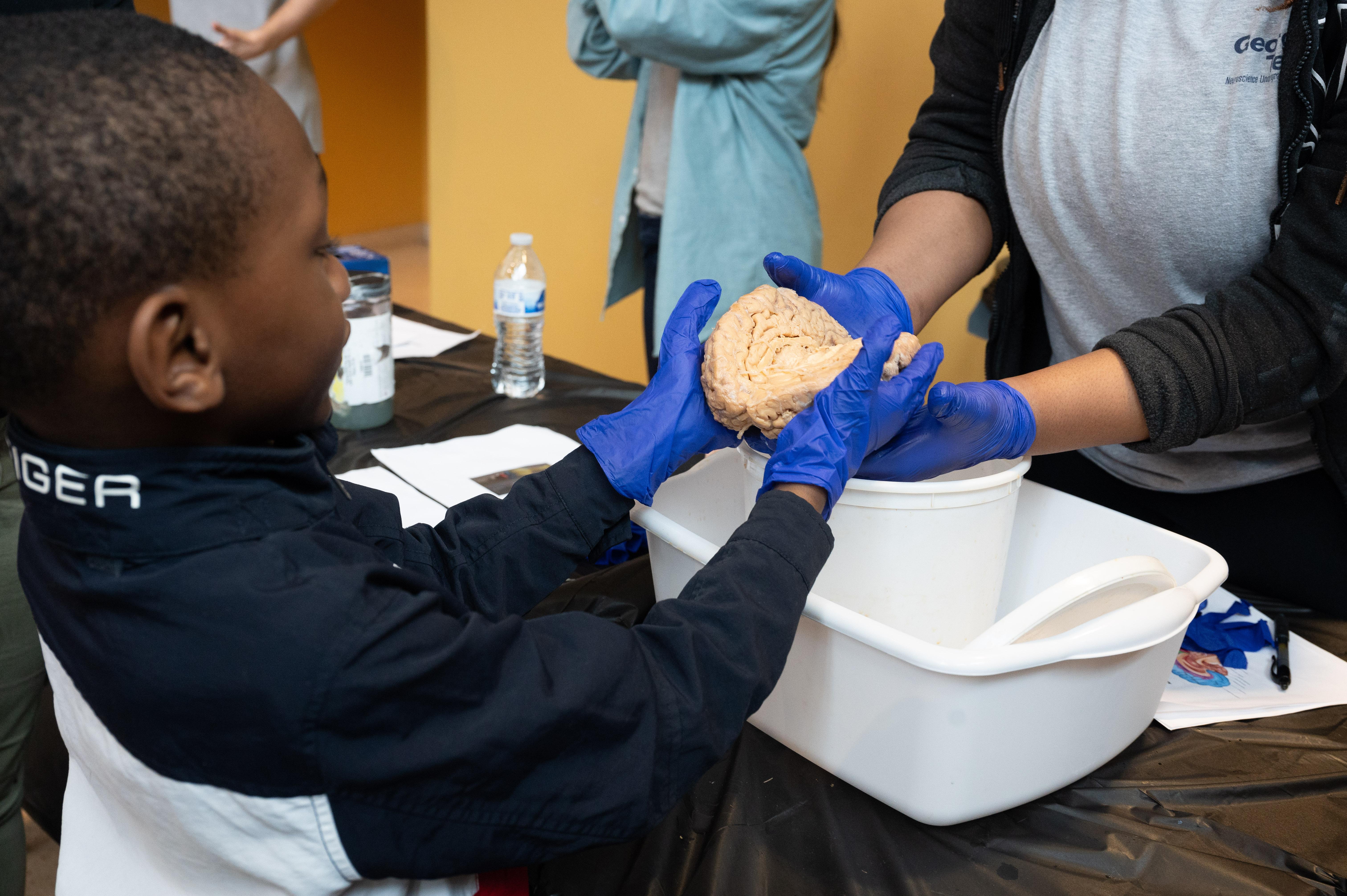
A young investigator holds a human brain. (Credit: Joya Chapman)
Georgia Tech opened the 11th annual Atlanta Science Festival (ASF) with record attendance for Science and Engineering Day. Despite the drizzly weather, about 4,000 people of all ages from throughout metro Atlanta — more than double the number of attendees in 2023 — visited campus on Saturday, March 9, 2024, for the space-themed event. They explored more than 45 exhibitions and hands-on activities related to art, robotics, nanotechnology, chemical and systems engineering, and biology, as well as other STEAM areas.
Visitors began their investigations at “Earth” (the Kendeda Building for Innovative Sustainable Design), where they picked up a galactic passport specially designed to guide them from building to building — each designated with the name of a planet — and the demonstrations housed within.
At “Mars” (Marcus Nanotechnology Building), attendees measured their height in nanometers, experimented with fruit batteries, and took a window-tour of the largest cleanroom in the Southeast, where semiconductors are developed. Inside “Venus” (Parker H. Petit Biotech Building), budding scientists examined bioluminescent bacteria under a microscope and made Play-Doh models of the human brain. When visiting “Saturn” (Ford Environmental Sciences and Technology Building), visitors studied density by making DIY lava lamps and inspected human brain specimens the way a pathologist would.
“Getting to hold a human brain was cool,” said a 12-year-old participant from Alpharetta. “And I also liked comparing it to the brains of a pig and a mouse.”
Other activities included math games and puzzles, the opportunity to build an artificial hand and a gallery display of research-inspired artwork. Georgia Tech faculty, students, and staff hosted all the demonstrations and served as volunteers who helped Science and Engineering Day guests navigate campus and the demonstration sites.
For many participants, the undoubted highlight was the chance to hear a presentation by former NASA astronaut and Georgia Tech alumnus Shane Kimbrough, MS OR 1998. Kimbrough spent 388 days in space over three missions and served as commander of the International Space Station (ISS) in 2016. He captivated the standing-room-only crowd with photos and descriptions of his time living and working aboard the ISS and answered questions from the kids in the audience.
“It’s really exciting to see all the activities around campus today … we’re inspiring the next generation of scientists and explorers for our country,” Kimbrough said afterward.
The event was a resounding success for Georgia Tech and the Atlanta Science Fair.
Lauren Overton-Kirk, who organized the event for the Institute, said, "Georgia Tech Science and Engineering Day 2024 was so wonderful to share with the community. What started years ago as a day for young scientific exploration became an all-ages, space-themed scientific spectacular. You could feel the passion for learning fill the campus in a way only Georgia Tech could do.”
Both the Georgia Tech and the Atlanta Science Festival teams are looking forward to next year’s Science and Engineering Day.
“As one of the founding organizations of the Atlanta Science Festival, Georgia Tech has been deeply invested in sharing the Institute’s innovations with the community,” said Meisa Salaita, ASF co-director. “And that investment was deeply evident on March 9th as they opened their doors to kick off the 11th annual Science Festival. Their students and faculty came out with enthusiasm to showcase science to the public. We couldn't be more thrilled with this partnership — and the many ways Tech has helped us show our community that Atlanta is a science city.”
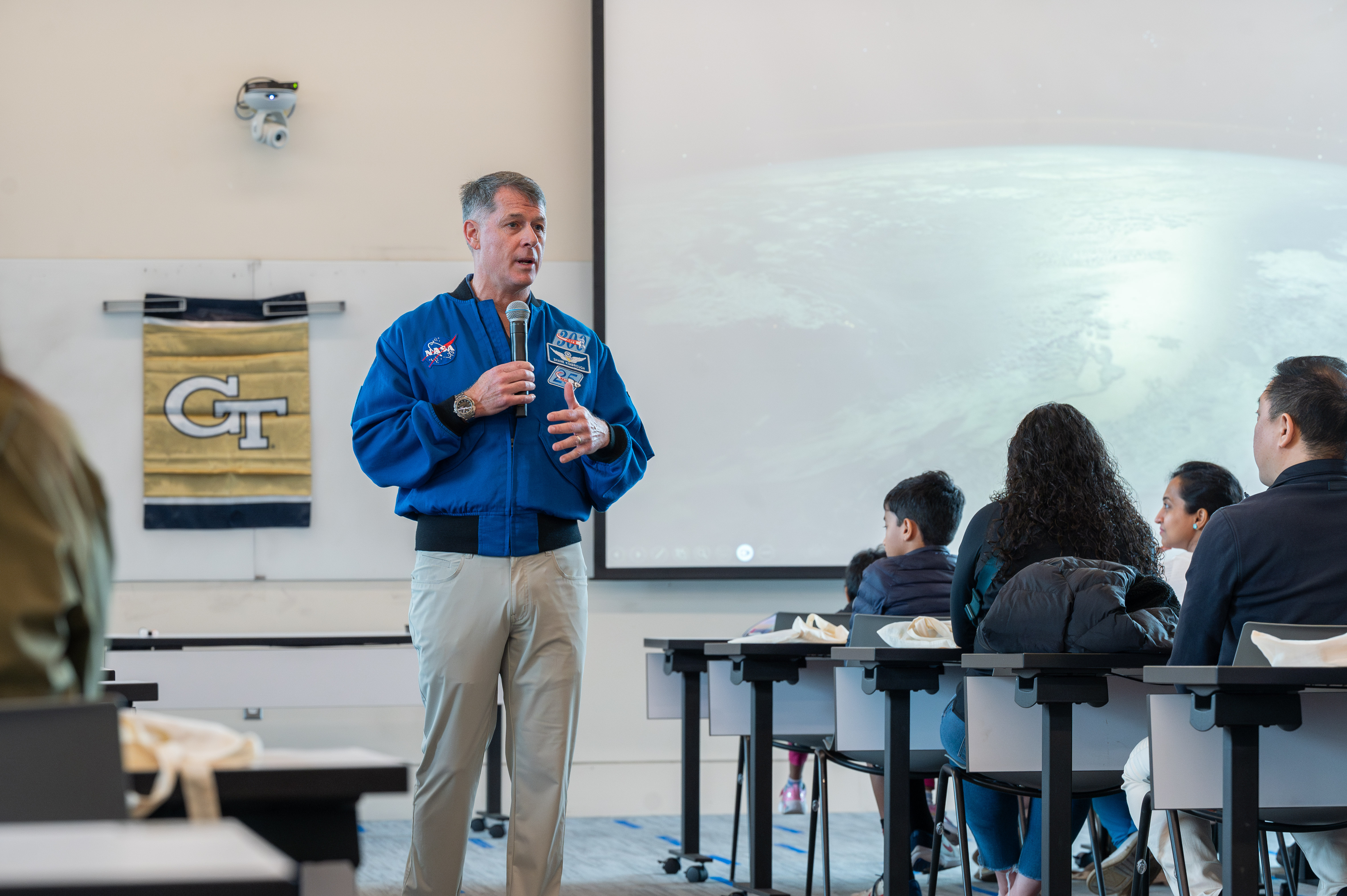
Former astronaut and Tech Alumnus Shane Kimbrough described what it was like to live and work in space to a packed crowd at Science and Engineering Day. (Credit: Joya Chapman)
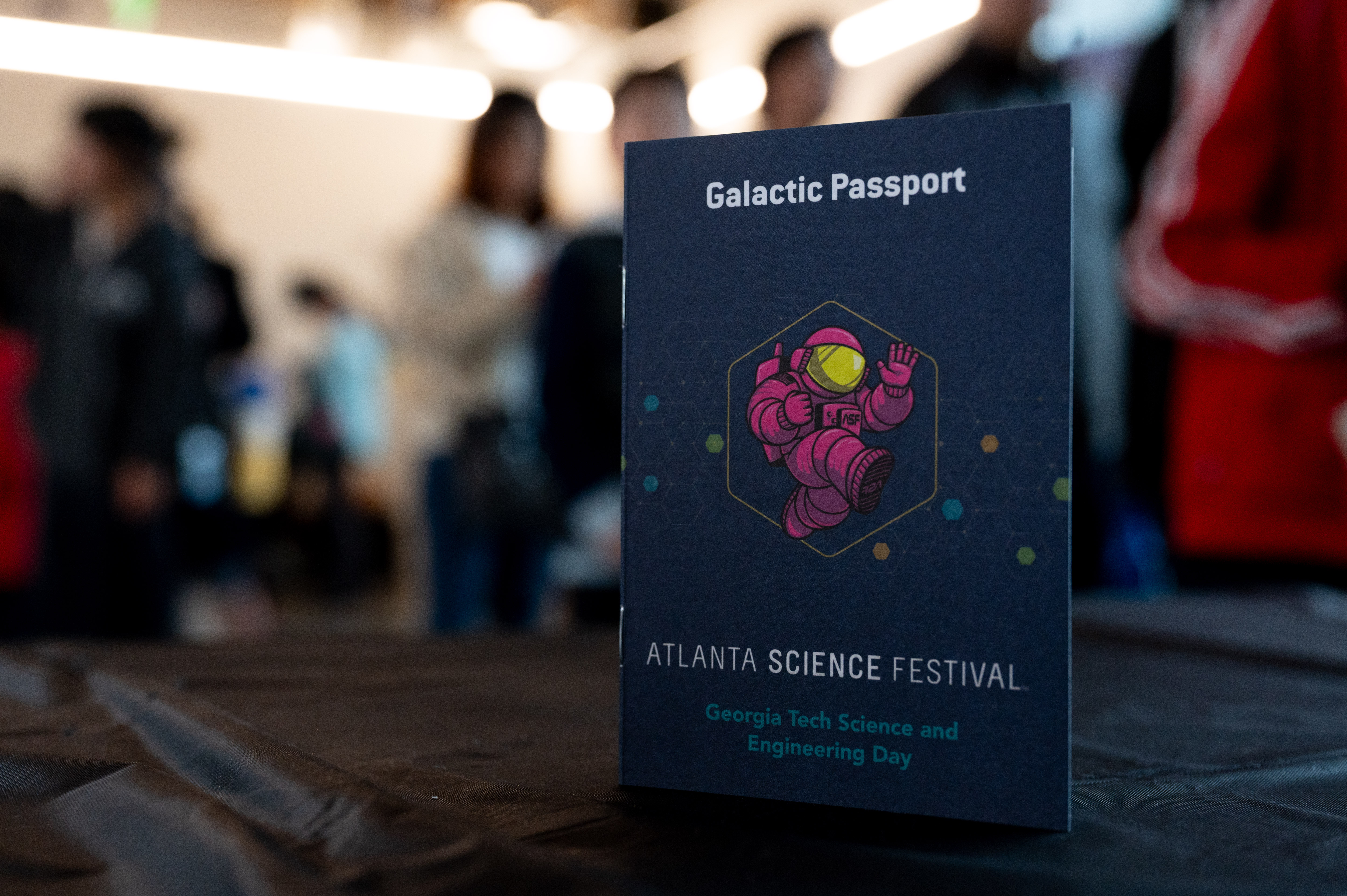
The Atlanta Science Festival Galactic Passport that visitors used to navigate their explorations around Georgia Tech's campus (Credit: Joya Chapman)
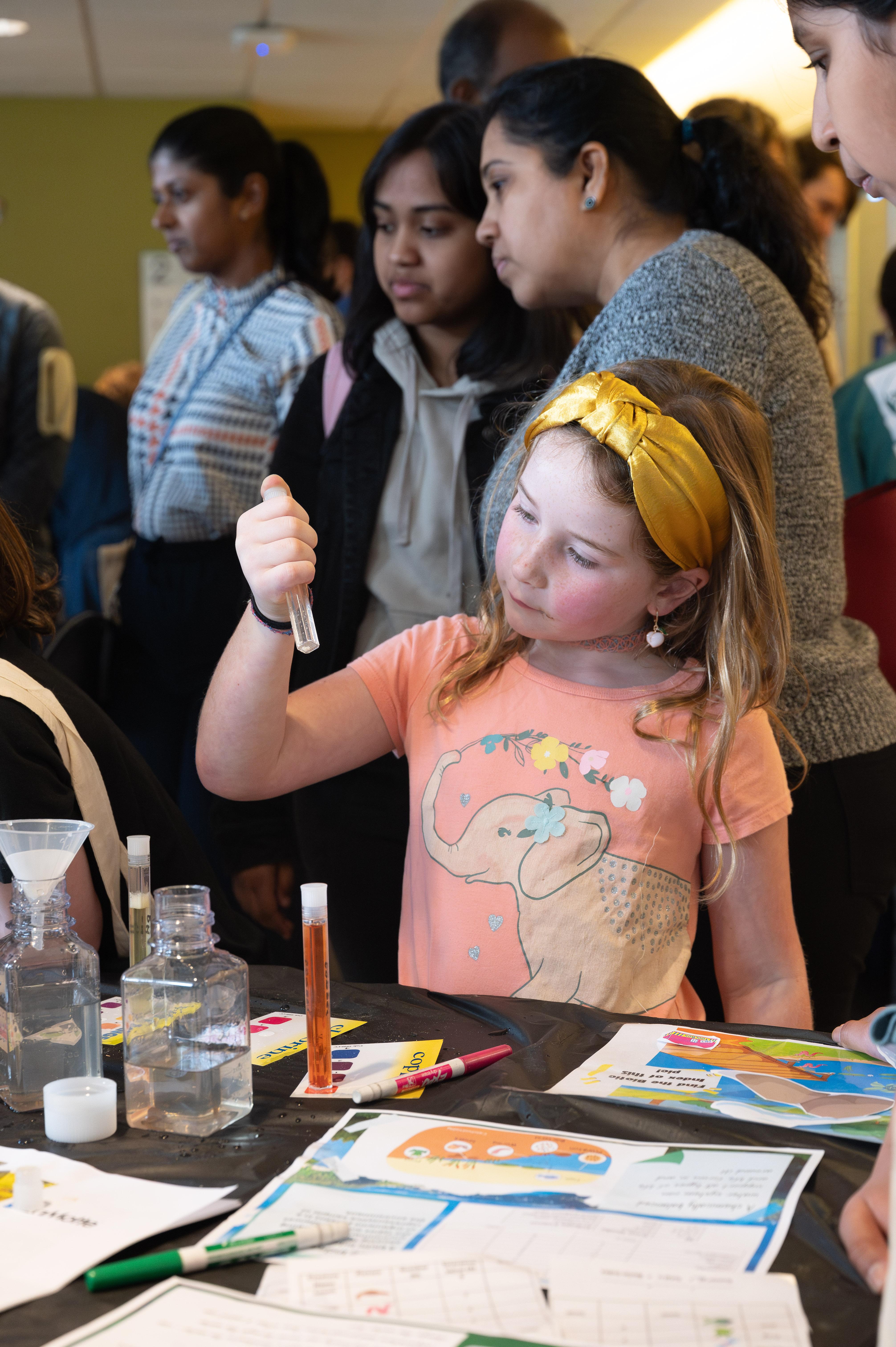
This guest at Science and Engineering Day examines tiny living organisms in a test tube. (Credit: Joya Chapman)

A budding scientist examines bioluminescent bacteria under a microscope. (Credit: Joya Chapman)
Shelley Wunder-Smith, Institute Communications
